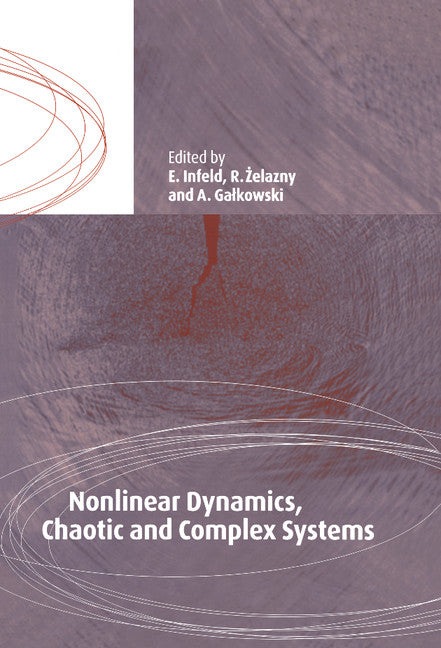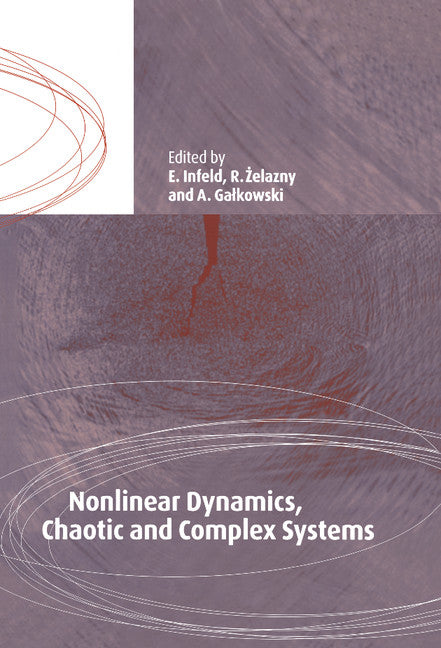Freshly Printed - allow 8 days lead
Couldn't load pickup availability
Nonlinear Dynamics, Chaotic and Complex Systems
Proceedings of an International Conference Held in Zakopane, Poland, November 7-12 1995, Plenary Invited Lectures
This book contains reviews of the 'nonlinear revolution' by two dozen world experts.
E. Infeld (Edited by), R. Zelazny (Edited by), A. Galkowski (Edited by)
9780521582018, Cambridge University Press
Hardback, published 19 June 1997
352 pages
22.9 x 15.2 x 2.4 cm, 0.69 kg
The physics and mathematics of nonlinear dynamics and chaotic and complex systems constitute some of the most fascinating developments of late twentieth-century science. It turns out that chaotic behaviour can be understood, and even utilized, to a far greater degree than had been suspected. Surprisingly, universal constants have been discovered. The implications have changed our understanding of important phenomena in physics, biology, chemistry, economics, medicine and numerous other fields of human endeavour. In this book, two dozen scientists and mathematicians who were deeply involved in the 'nonlinear revolution' cover most of the basic aspects of the field. The book is divided into five parts: dynamical systems, bifurcation theory and chaos; spatially extended systems; dynamical chaos, quantum physics and the foundations of statistical mechanics; evolutionary and cognitive systems; and complex systems as an interface between the sciences.
Part I. Dynamic Systems Bifurcation Theory and Chaos: 1. Chaos in random dynamical systems V. M. Gunldach
2. Controlling chaos using embedded unstable periodic orbits: the problem of optimal periodic orbits B. R. Hunt and E. Ott
3. Chaotic tracer dynamics in open hydrodynamical flows G. Karolyi, A. Pentek, T. Tel and Z. Toroczkai
4. Homoclinic chaos L. P. Shilnikov
Part II. Spatially Extended Systems: 5. Hydrodynamics of relativistic probability flows I. Bialynicki-Birula
6. Waves in ionic reaction-diffusion-migration systems P. Hasal, V. Nevoral, I. Schreiber, H. Sevcikova, D. Snita, and M. Marek
7. Anomalous scaling in turbulence: a field theoretical approach V. Lvov and I. Procaccia
8. Abelian sandpile cellular automata M. Markosova
9. Transport in an incompletely chaotic magnetic field F. Spineanu
Part III. Dynamical Chaos Quantum Physics and Foundations Of Statistical Mechanics: 10. Non-equilibrium statistical mechanics and ergodic theory L. A. Bunimovich
11. Pseudochaos in statistical physics B. Chirikov
12. Foundations of non-equilibrium statistical mechanics J. P. Dougherty
13. Thermomechanical particle simulations W. G. Hoover, H. A. Posch, C. H. Dellago, O. Kum, C. G. Hoover, A. J. De Groot and B. L. Holian
14. Quantum dynamics on a Markov background and irreversibility B. Pavlov
15. Time chaos and the laws of nature I. Prigogine and D. J. Driebe
16. Evolutionary Q and cognitive systems: dynamic entropies and predictability of evolutionary processes W. Ebeling
17. Spatiotemporal chaos information processing in neural networks H. Szu
18. Phase transitions and learning in neural networks C. Van den Broeck
19. Synthesis of chaos A. Vanecek and S. Celikovsky
20. Computational complexity of continuous problems H. Wozniakowski
Part IV. Complex Systems As An Interface Between Natural Sciences and Environmental Social and Economic Sciences: 21. Stochastic differential geometry in finance studies V. G. Makhankov
Part V. Conference Banquet Speech: Where will the future go? M. J. Feigenbaum.
Subject Areas: Nonlinear science [PBWR]


